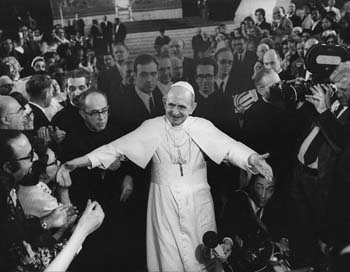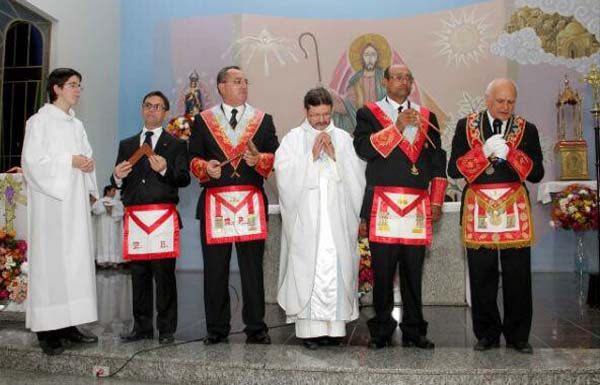Consequences of Vatican II
 |
 |
 |
 |
 |
 |
 |
The Church of Man – Part I
A Fundamental Inversion in
the Goals of the Church
On December 7, 1965, in his closing speech at Vatican Council II, Pope Paul VI announced: “The Church had decided to serve man, to help man build a home here on this earth.”
According to Paul VI, the present day authorities of the Catholic Church would no longer be assisting the faithful to fulfill the supernatural purpose for which they were created, which is “to know, love and serve God, and to be forever with Him in Heaven.” Thus, the main goals of the Church, established by Christ for the purpose of giving honor and glory to God and the salvation of souls, were inverted. Not the salvation of souls, but the improvement of human welfare became a major goal for the conciliar Church.
 Since the Pope was well aware of the words of Jesus - “Seek ye therefore the kingdom of God and His justice and all these things shall be added unto you” (Mt 6:33) - this change in purpose was indeed a most radical change.
Since the Pope was well aware of the words of Jesus - “Seek ye therefore the kingdom of God and His justice and all these things shall be added unto you” (Mt 6:33) - this change in purpose was indeed a most radical change.
In the same speech the Pope also said:
“The conciliar Church, it is true, has also been much concerned with man, with man as he really is today, with living man, with man totally taken up with himself, with man who not only makes himself the center of his own interests, but who dares to claim that he is the end and aim of all existence.
“Secular, profane, humanism has finally revealed itself in its terrible shape and has, in a certain sense, challenged the Council. The religion of God made man has come up against a religion – for there is such a one – of man who makes himself God.”
“And what happened? An impact, a battle, an anathema? That might have taken place, but it did not. It was the old story of the Samaritan that formed the model for the Council's spirituality. It was permeated only with endless boundless sympathy. The attention of our Council was taken up with the discovery of human needs - which become greater as the son of the earth makes himself greater. …
“Do you at least recognize this merit, you modern humanists who have no place for the transcendence of the things supreme, and come to know our new humanism: we also, we more than anyone else, have the cult of man.” (Ibid.)
Four years later on July 13, 1969, Paul VI again emphasized this new elevation of man by declaring:
“Man is both giant and divine, in his origin and his destiny. Honor, therefore, to man, honor to his dignity, to his spirit, to his life."
Thus, according to the Pope, not only would the purpose of the Church be radically changed, but so also would the relation between God and man. The fulfilling of both the new purpose of the Church and the new “status” of man is based upon such intangible notions as dialogue, unity in diversity, building a worldwide community of love through dialogue, attaining a unity in diversity among all peoples of the world, establishing a one world man-defined ‘religion’, etc.
The new objective is clearly unattainable as it contradicts Jesus’ words quoted above as well as God’s words in Jeremiah: 'Cursed be the man that trusts in man and makes flesh his arm and whose heart departed from the Lord' (17.5).
The Council inspired changes in the basic tenets of the faith and its liturgical rites as they were understood prior to the Council. The changes emphasized such actions as the collaboration with authorities of different religious sects, as well as with secular authorities for the improvement of human welfare, the attainment of world peace, etc. To attain the new objectives, Christ’s teachings were blithely ignored, as well as His purpose for His Church.
 For many centuries prior to Vatican II, the Church was devoted to helping the faithful fulfill Christ’s admonition in Matthew 6:33. As a consequence, the Church enjoyed a steady period of growth in the numbers of its members, its clergy and its religious institutions. Throughout the world both her moral authority and her social influence was respected.
For many centuries prior to Vatican II, the Church was devoted to helping the faithful fulfill Christ’s admonition in Matthew 6:33. As a consequence, the Church enjoyed a steady period of growth in the numbers of its members, its clergy and its religious institutions. Throughout the world both her moral authority and her social influence was respected.
In addition, the charitable work of the Church was greatly admired due to the large number of schools and hospitals she had built, supported and operated and made available to many of the poor.
However, soon after the close of Vatican II tens of thousands of religious and clergy abandoned the Church. Their abandonment led to the curtailing of many religious services, the closing of hundreds of Catholic schools and the severe limiting of the ability of Catholic hospitals and charitable organizations to provide medical and charitable services to the poor.
Furthermore, the Catholic Faith was abandoned by hundreds of thousands of Catholics. This devastation of the Church began almost immediately after the close of the Council. It quickly became so evident that, just three years after its close, Paul VI felt forced to declare: “The Church is in the process of auto-demolition.”
The sudden and sharp loss in the religious and moral influence of the Church has been so noticeable that it has raised much discussion among both Catholics and non-Catholics. Sadly, this self-destruction continues unabated due to of the novel teachings and actions by conciliar Church authorities.
 Continued
Continued

According to Paul VI, the present day authorities of the Catholic Church would no longer be assisting the faithful to fulfill the supernatural purpose for which they were created, which is “to know, love and serve God, and to be forever with Him in Heaven.” Thus, the main goals of the Church, established by Christ for the purpose of giving honor and glory to God and the salvation of souls, were inverted. Not the salvation of souls, but the improvement of human welfare became a major goal for the conciliar Church.

Paul VI sets a new mission: The church must serve man
In the same speech the Pope also said:
“The conciliar Church, it is true, has also been much concerned with man, with man as he really is today, with living man, with man totally taken up with himself, with man who not only makes himself the center of his own interests, but who dares to claim that he is the end and aim of all existence.
“Secular, profane, humanism has finally revealed itself in its terrible shape and has, in a certain sense, challenged the Council. The religion of God made man has come up against a religion – for there is such a one – of man who makes himself God.”
“And what happened? An impact, a battle, an anathema? That might have taken place, but it did not. It was the old story of the Samaritan that formed the model for the Council's spirituality. It was permeated only with endless boundless sympathy. The attention of our Council was taken up with the discovery of human needs - which become greater as the son of the earth makes himself greater. …
“Do you at least recognize this merit, you modern humanists who have no place for the transcendence of the things supreme, and come to know our new humanism: we also, we more than anyone else, have the cult of man.” (Ibid.)
Four years later on July 13, 1969, Paul VI again emphasized this new elevation of man by declaring:
“Man is both giant and divine, in his origin and his destiny. Honor, therefore, to man, honor to his dignity, to his spirit, to his life."
Thus, according to the Pope, not only would the purpose of the Church be radically changed, but so also would the relation between God and man. The fulfilling of both the new purpose of the Church and the new “status” of man is based upon such intangible notions as dialogue, unity in diversity, building a worldwide community of love through dialogue, attaining a unity in diversity among all peoples of the world, establishing a one world man-defined ‘religion’, etc.
The new objective is clearly unattainable as it contradicts Jesus’ words quoted above as well as God’s words in Jeremiah: 'Cursed be the man that trusts in man and makes flesh his arm and whose heart departed from the Lord' (17.5).
The Council inspired changes in the basic tenets of the faith and its liturgical rites as they were understood prior to the Council. The changes emphasized such actions as the collaboration with authorities of different religious sects, as well as with secular authorities for the improvement of human welfare, the attainment of world peace, etc. To attain the new objectives, Christ’s teachings were blithely ignored, as well as His purpose for His Church.

Francis sent a letter to Prime Minister Cameron: 'The goal of economics and politics is to serve humanity'
In addition, the charitable work of the Church was greatly admired due to the large number of schools and hospitals she had built, supported and operated and made available to many of the poor.
However, soon after the close of Vatican II tens of thousands of religious and clergy abandoned the Church. Their abandonment led to the curtailing of many religious services, the closing of hundreds of Catholic schools and the severe limiting of the ability of Catholic hospitals and charitable organizations to provide medical and charitable services to the poor.
Furthermore, the Catholic Faith was abandoned by hundreds of thousands of Catholics. This devastation of the Church began almost immediately after the close of the Council. It quickly became so evident that, just three years after its close, Paul VI felt forced to declare: “The Church is in the process of auto-demolition.”
The sudden and sharp loss in the religious and moral influence of the Church has been so noticeable that it has raised much discussion among both Catholics and non-Catholics. Sadly, this self-destruction continues unabated due to of the novel teachings and actions by conciliar Church authorities.

The Conciliar Church assumed the humanist ideals of Freemasonry;
above a Mass said for Freemasons in Brazil

Posted June 17, 2013
______________________
______________________











